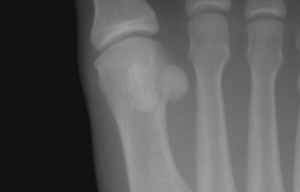Sesamoid: Difference between revisions
No edit summary |
Kim Jackson (talk | contribs) No edit summary |
||
| (8 intermediate revisions by 2 users not shown) | |||
| Line 1: | Line 1: | ||
<div class="editorbox"> | <div class="editorbox"> | ||
'''Original Editor''' - [[User: | '''Original Editor ''' - [[User:Patti Cavaleri|Patti Cavaleri]] | ||
'''Top Contributors''' - {{Special:Contributors/{{FULLPAGENAME}}}} | '''Top Contributors''' - {{Special:Contributors/{{FULLPAGENAME}}}} | ||
</div> | </div> | ||
== Description == | == Description == | ||
[[File:Sesamoid Bone.png|thumb]] | |||
Sesamoid bones are a type of bone that develop in some tendons where they cross the ends of long bones<ref name=":0">Moore KL, Dalley AF, R. AAM. Clinically oriented anatomy. Philadelphia, PA: Lippincott Williams and Wilkins; 2018.</ref>. Sesamoids ossify during puberty and delayed ossification can indicate delayed onset of puberty. | |||
Sesamoid bones in the human body include: | |||
* [[Patella]] - in the [[Quadriceps Muscle|quadriceps]] tendon at the knee | |||
* Hallux sesamoids - medial/[[tibia]] and lateral/fibular in the [[Flexor Hallucis Brevis|flexor hallucis brevis]] tendon at the 1st metatarsophalangeal joint | |||
* In the hand at the head of the 1st metacarpal - one in the combined tendon of the [[Flexor Pollicis Brevis|flexor pollicis brevis]] and [[Abductor Pollicis Brevis|abductor pollicis brevis]] and one in the tendon of the [[Adductor Pollicis|adductor pollicis]] | |||
* [[Pisiform]] - in the [[Flexor Carpi Ulnaris Muscle|flexor carpi ulnaris]] tendon | |||
== Function == | == Function == | ||
Sesamoids protect tendons from excessive wear and act as a spacer to change the angle of tendons before the reach their attachment point<ref name=":0" />. The change in angle improves muscle force generation. | |||
== Clinical relevance == | == Clinical relevance == | ||
Pathology in sesamoids can be congenital or a result of trauma. Common pathology seen in sesamoid bones include: | |||
* Bipartite or multipartite patella<ref>Oohashi Y, Koshino T, Oohashi Y. Clinical features and classification of bipartite or tripartite patella. Knee Surg Sports Traumatol Arthrosc. 2010 Nov;18(11):1465-9.</ref> | |||
* [[Sesamoiditis]] | |||
* Fracture - such as [[Patellar Fractures|patella fracture]] | |||
* [[Avascular Necrosis|Avascular necrosis]]<ref>Bartosiak K, McCormick JJ. Avascular Necrosis of the Sesamoids. Foot Ankle Clin. 2019 Mar;24(1):57-67.</ref> | |||
Management of the different pathologies varies depending on the diagnosis. Physiotherapy or conservative management is typically the first line of treatment for atraumatic pathology of sesamoids. | |||
= | {{#ev:youtube|YPiEc8OZAKU|300}}<ref>RegisteredNurseRN. Types of Bones Anatomy: Long, Short, Flat, Irregular, Sesamoid, Sutural. Available from: https://www.youtube.com/watch?v=YPiEc8OZAKU [last accessed 21/2/2022]</ref> | ||
Sesamoid bones are discussed at 1:32. | |||
== References == | |||
<references /> | <references /> | ||
[[Category:Anatomy]] [[Category:Bones]] | [[Category:Anatomy]] [[Category:Bones]] | ||
[[Category:Hand - Anatomy]] | |||
[[Category:Knee - Bones]] | |||
[[Category:Foot - Bones]] | |||
Latest revision as of 15:40, 3 July 2023
Original Editor - Patti Cavaleri
Top Contributors - Patti Cavaleri, Wendy Snyders and Kim Jackson
Description[edit | edit source]
Sesamoid bones are a type of bone that develop in some tendons where they cross the ends of long bones[1]. Sesamoids ossify during puberty and delayed ossification can indicate delayed onset of puberty.
Sesamoid bones in the human body include:
- Patella - in the quadriceps tendon at the knee
- Hallux sesamoids - medial/tibia and lateral/fibular in the flexor hallucis brevis tendon at the 1st metatarsophalangeal joint
- In the hand at the head of the 1st metacarpal - one in the combined tendon of the flexor pollicis brevis and abductor pollicis brevis and one in the tendon of the adductor pollicis
- Pisiform - in the flexor carpi ulnaris tendon
Function[edit | edit source]
Sesamoids protect tendons from excessive wear and act as a spacer to change the angle of tendons before the reach their attachment point[1]. The change in angle improves muscle force generation.
Clinical relevance[edit | edit source]
Pathology in sesamoids can be congenital or a result of trauma. Common pathology seen in sesamoid bones include:
- Bipartite or multipartite patella[2]
- Sesamoiditis
- Fracture - such as patella fracture
- Avascular necrosis[3]
Management of the different pathologies varies depending on the diagnosis. Physiotherapy or conservative management is typically the first line of treatment for atraumatic pathology of sesamoids.
Sesamoid bones are discussed at 1:32.
References[edit | edit source]
- ↑ 1.0 1.1 Moore KL, Dalley AF, R. AAM. Clinically oriented anatomy. Philadelphia, PA: Lippincott Williams and Wilkins; 2018.
- ↑ Oohashi Y, Koshino T, Oohashi Y. Clinical features and classification of bipartite or tripartite patella. Knee Surg Sports Traumatol Arthrosc. 2010 Nov;18(11):1465-9.
- ↑ Bartosiak K, McCormick JJ. Avascular Necrosis of the Sesamoids. Foot Ankle Clin. 2019 Mar;24(1):57-67.
- ↑ RegisteredNurseRN. Types of Bones Anatomy: Long, Short, Flat, Irregular, Sesamoid, Sutural. Available from: https://www.youtube.com/watch?v=YPiEc8OZAKU [last accessed 21/2/2022]







